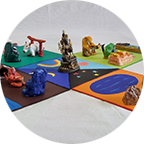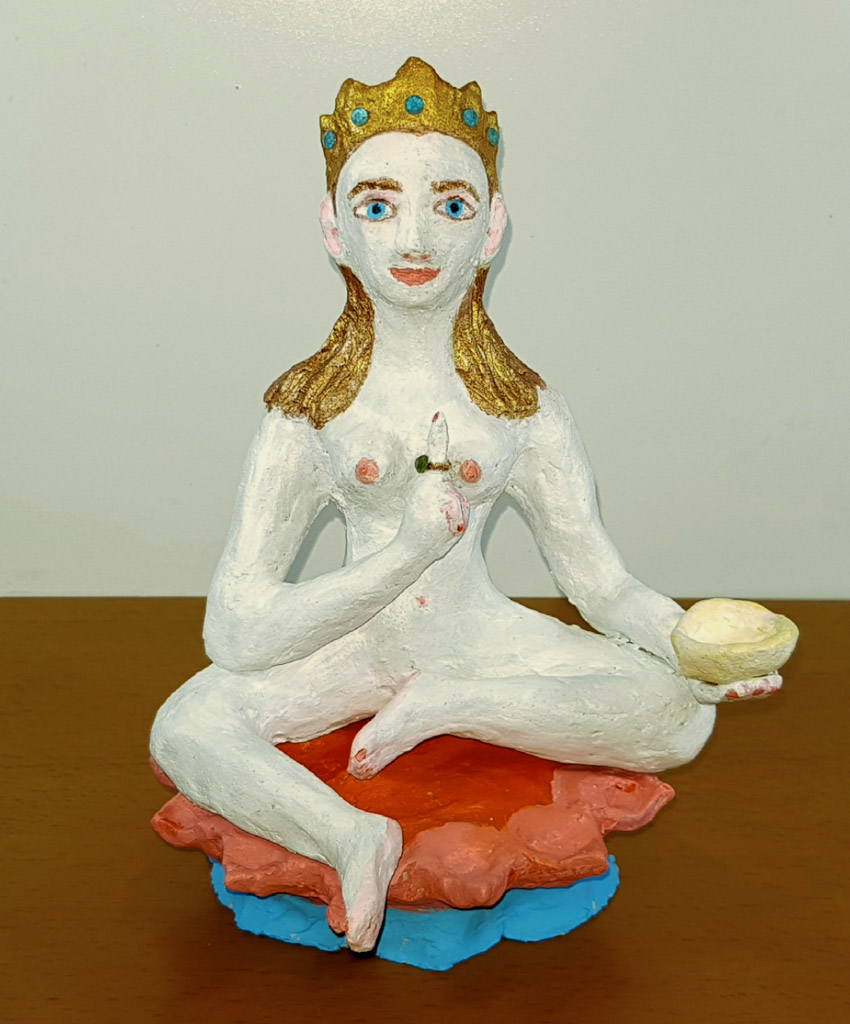Author: Vladimir Pyatsky
Translation: NatashaTsimbler
Interacting with the sick and infirm can be burdensome for an untrained mind. An ordinary mind clings to pleasant feelings and recoils from unpleasant ones. Therefore it feels vulnerable and anxious. To overcome the fear of engaging with suffering individuals, a special kind of character training is required. The best method for such training, in my view, is to train yourself to communicate with deities, which are higher, virtuous qualities of one’s own mind. When practitioners recognize these qualities, they feel protected and become gentle and patient in their interactions with those who are immersed in suffering. One of the most effective visualization techniques for those caring for the sick is to imagine their own mind in the form of the Medicine Buddha, who alleviates physical and emotional suffering, offering those in distress a touch of peace.
Fear is one of the main obstacles to abiding in deep tranquility, so overcoming fear should be a key focus when visualizing the Medicine Buddha.
All fears, in one way or another, stem from the fear of death. However, beyond this direct form, the fear also manifests in four derivative forms: the fear of old age, the fear of illness, the fear of loneliness, and the fear of poverty.
Below is an example of how one can work on reducing these five fears through contemplation of the Medicine Buddha.
A Method for Contemplating the Medicine Buddha
The Medicine Buddha, with his deep blue body, can be visualized in front of the forehead at a distance approximately equal to the length of the practitioner’s forearm, or in front of the heart approximately at the arm’s length. One can also visualize the Buddha on the floor in front of one’s feet, at a distance roughly equal to the length of the practitioner’s body.
The size of the Buddha’s body can be imagined approximately as the size of a contemplator’s thumb when visualized in front of the forehead, the size of a hand when visualized in front of the chest, and the size of a contemplator’s body when visualized on the floor. The blue color of his body symbolizes boundless space. One should visualize the Buddha seated with his legs crossed, his back straight and his hands folded in Dhyana-Mudra and holding the vajra that is built of medicinal herbs’ incense smoke. The Buddha holds his vajra near his lower abdomen. The base of the vajra is positioned at the pubic symphysis and its tip is near the navel. The Buddha’s throne consists of two disks: a yellow Moon disk and, beneath it, a red Sun disk. Both disks rest on the petals of a white, eight-petaled lotus. The Medicine Buddha’s face radiates serene benevolence, attentiveness, and deep understanding. Surrounding his body is an iridescent aura in the form of a five-colored sphere. At the heart center of the Medicine Buddha’s empty form resides the benevolent mantra HRIM. This mantra of serene joy, as if delicately inscribed in sky-blue with a single fine hair, emits pure and gentle rays, filling the deity’s entire body and seeping through the pores of his skin.
Overcoming the Five Fears
1. Fear of Death
The main quality of the Medicine Buddha is relaxation, similar to the relaxation of a deep sleep state without dreams. The healing properties of deep relaxation are well known. In Medicine Buddha practice, deep sleep is viewed as complete absorption of sensory activity into the luminous emptiness of the mind. The Buddha’s crossed legs, resting on the throne of the lotus, Sun, and Moon, symbolize a relaxed mind that has reached its inner goal and ceased its restless wandering. These aspects of the deity’s contemplation help reduce the fear of death, because in the state of deep relaxation the mind ceases to identify with the body, which is subject to birth and death.
2. Fear of Aging
The Medicine Buddha’s balanced posture and radiant glow of his blue body lessen the fear of aging and decay. The gross physical body is subject to aging and deterioration, but the mind can retain the qualities of vitality and strength that characterize youth. The youthfulness of the mind is preserved in the heart like a seed inside a fruit. Though the fruit (the body) withers and disintegrates over time, the seed of the mind retains all the potential of its original state. The blue color of space (the Buddha’s body) represents this seed. The rainbow glow surrounding the Buddha’s body signifies the movement of the five elements that constitute the gross body (time, wind, fire, water, earth).
3. Fear of Illness
The smoke-like vajra in the Buddha’s hands reduces the fear of sickness. The fragrant smoke of the healing herbs from which the vajra is made serves as a subtle medicine that can be produced and absorbed through meditative practice.
4. Fear of Loneliness
The attentive and benevolent expression on the Medicine Buddha’s face reduces the fear of loneliness, as the Buddha makes the space of inner dialogue comfortable and pleasant.
5. Fear of Poverty
The mantra HRIM at the heart center of the deity diminishes the fear of poverty, as it represents the possession of the highest wealth – joyful peace, the ultimate treasure that all beings seek through material pursuits.
In the practice of visualization, it is helpful to anchor the reflections on the deity with short prayers.
A Prayer to the Medicine Buddha
All-blessed refuge-giving protector of consciousness!
I bow at your feet and remain under your compassionate gaze.
Merging in thought with you, may I heal my mind from the five fears!
May the three spheres of my consciousness – past, present, and future – reveal their pure illusory nature, becoming your throne of the Moon, the Sun, and the White Lotus.
Seeing the entire world within you, may I bring benefit to all sentient beings!
Author
Author: Vladimir Pyatsky
Translation: NatashaTsimbler
Interacting with the sick and infirm can be burdensome for an untrained mind. An ordinary mind clings to pleasant feelings and recoils from unpleasant ones. Therefore it feels vulnerable and anxious. To overcome the fear of engaging with suffering individuals, a special kind of character training is required. The best method for such training, in my view, is to train yourself to communicate with deities, which are higher, virtuous qualities of one’s own mind. When practitioners recognize these qualities, they feel protected and become gentle and patient in their interactions with those who are immersed in suffering. One of the most effective visualization techniques for those caring for the sick is to imagine their own mind in the form of the Medicine Buddha, who alleviates physical and emotional suffering, offering those in distress a touch of peace.
Fear is one of the main obstacles to abiding in deep tranquility, so overcoming fear should be a key focus when visualizing the Medicine Buddha.
All fears, in one way or another, stem from the fear of death. However, beyond this direct form, the fear also manifests in four derivative forms: the fear of old age, the fear of illness, the fear of loneliness, and the fear of poverty.
Below is an example of how one can work on reducing these five fears through contemplation of the Medicine Buddha.
A Method for Contemplating the Medicine Buddha
The Medicine Buddha, with his deep blue body, can be visualized in front of the forehead at a distance approximately equal to the length of the practitioner’s forearm, or in front of the heart approximately at the arm’s length. One can also visualize the Buddha on the floor in front of one’s feet, at a distance roughly equal to the length of the practitioner’s body.
The size of the Buddha’s body can be imagined approximately as the size of a contemplator’s thumb when visualized in front of the forehead, the size of a hand when visualized in front of the chest, and the size of a contemplator’s body when visualized on the floor. The blue color of his body symbolizes boundless space. One should visualize the Buddha seated with his legs crossed, his back straight and his hands folded in Dhyana-Mudra and holding the vajra that is built of medicinal herbs’ incense smoke. The Buddha holds his vajra near his lower abdomen. The base of the vajra is positioned at the pubic symphysis and its tip is near the navel. The Buddha’s throne consists of two disks: a yellow Moon disk and, beneath it, a red Sun disk. Both disks rest on the petals of a white, eight-petaled lotus. The Medicine Buddha’s face radiates serene benevolence, attentiveness, and deep understanding. Surrounding his body is an iridescent aura in the form of a five-colored sphere. At the heart center of the Medicine Buddha’s empty form resides the benevolent mantra HRIM. This mantra of serene joy, as if delicately inscribed in sky-blue with a single fine hair, emits pure and gentle rays, filling the deity’s entire body and seeping through the pores of his skin.
Overcoming the Five Fears
1. Fear of Death
The main quality of the Medicine Buddha is relaxation, similar to the relaxation of a deep sleep state without dreams. The healing properties of deep relaxation are well known. In Medicine Buddha practice, deep sleep is viewed as complete absorption of sensory activity into the luminous emptiness of the mind. The Buddha’s crossed legs, resting on the throne of the lotus, Sun, and Moon, symbolize a relaxed mind that has reached its inner goal and ceased its restless wandering. These aspects of the deity’s contemplation help reduce the fear of death, because in the state of deep relaxation the mind ceases to identify with the body, which is subject to birth and death.
2. Fear of Aging
The Medicine Buddha’s balanced posture and radiant glow of his blue body lessen the fear of aging and decay. The gross physical body is subject to aging and deterioration, but the mind can retain the qualities of vitality and strength that characterize youth. The youthfulness of the mind is preserved in the heart like a seed inside a fruit. Though the fruit (the body) withers and disintegrates over time, the seed of the mind retains all the potential of its original state. The blue color of space (the Buddha’s body) represents this seed. The rainbow glow surrounding the Buddha’s body signifies the movement of the five elements that constitute the gross body (time, wind, fire, water, earth).
3. Fear of Illness
The smoke-like vajra in the Buddha’s hands reduces the fear of sickness. The fragrant smoke of the healing herbs from which the vajra is made serves as a subtle medicine that can be produced and absorbed through meditative practice.
4. Fear of Loneliness
The attentive and benevolent expression on the Medicine Buddha’s face reduces the fear of loneliness, as the Buddha makes the space of inner dialogue comfortable and pleasant.
5. Fear of Poverty
The mantra HRIM at the heart center of the deity diminishes the fear of poverty, as it represents the possession of the highest wealth – joyful peace, the ultimate treasure that all beings seek through material pursuits.
In the practice of visualization, it is helpful to anchor the reflections on the deity with short prayers.
A Prayer to the Medicine Buddha
All-blessed refuge-giving protector of consciousness!
I bow at your feet and remain under your compassionate gaze.
Merging in thought with you, may I heal my mind from the five fears!
May the three spheres of my consciousness – past, present, and future – reveal their pure illusory nature, becoming your throne of the Moon, the Sun, and the White Lotus.
Seeing the entire world within you, may I bring benefit to all sentient beings!

